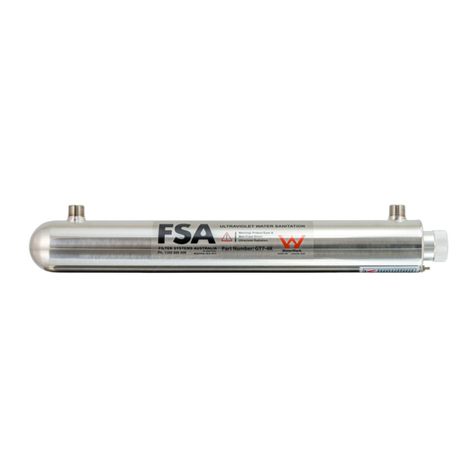
2. Oversized System
allowed to stand for long periods of time, the water
may be prone to heating up and may be either
lukewarm or hot. Generally, this only occurs on
systems that have a short distance between the
outlet and point of use. Whole house systems have
a larger length of cold plumbing pipes downstream
which will dissipate this heat.
2. If the system is too large for the application, it is
likely that even with frequent water usage, the water
does not get a chance to cool down effectively. If
there are significant fluctuations in usage or flow
rates, it is good practice to install a thermal relief
valve (sold separately) on the outlet of the UV
chamber which can bleed water from the chamber
and keep temperatures below 56°C.
1. As above, if the water is allowed to stand for
periods of time, the chamber will heat up naturally.
This is normal, however if the heating is excessive to
the point where it is causing damage to the chamber
or surrounding fixtures, a thermal relief valve (sold
separately) should be installed on the outlet of the
UV chamber, to bleed water from the chamber and
keep temperatures below 56°C.
2. False Alarm
1. Usually if the ballast is alarming and showing a
red flashing status indicating light, the lamp has
failed and will require replacement. Before replacing
a lamp, it is best to check firstly for an external
cause for lamp failure turn off the power then check
for; Water ingress from either rain, or leaks or any
signs of moisture or condensation in/around the
electricals. Due to the elevated temperature of the
lamp, high humidity may cause condensate to form.
If there are no signs of leaking, check for signs of
shorts or charring on the lamp connection with the
ballast. Lastly inspect the tube to see if there are any
dark patches or if the filaments are burnt out.
2. Sometimes the ballast may trigger a failure alarm
if the connection to the lamp is interrupted or
perhaps the connection is not solid enough. If the
above steps reveal no faults and the lamp is still
working (lighting up), turn the power off for 5
minutes, check connections and then turn it back on
to see if the fault clears.
2. Interrupted Power
Supply
1. In the event of a large surge it is possible that the
ballast failed. This can also occur from shorts and
water ingress. Check for signs of a short around the
lamp connection end. The ballast will need to be
replaced. The UV lamp may also have blown at the
same time, or could be the cause for the ballast
failure – for safety it is best to replace both the lamp
and ballast together. If it is within Warranty period
please contact the manufacturer for further
instructions.
2. Check the wall socket with a different electrical
appliance to check if the GPO is functioning. Also
check your circuit breaker to see if any switches are
the ballast is
1. The lamp may be lighting up but not working at its
full capacity which may be caused by it not drawing
enough power from the ballast. The lamp will require





























